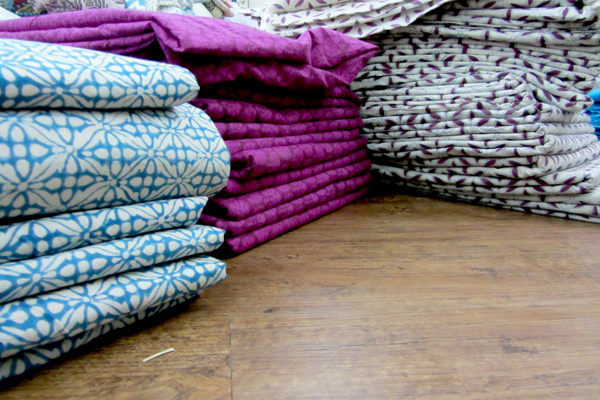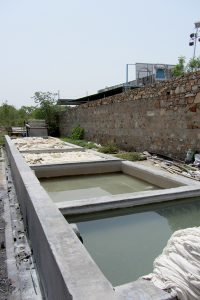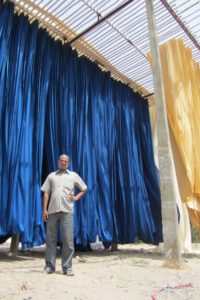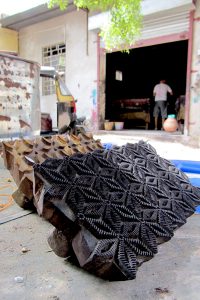Block printing
Deutsche Version
English version
J’ai choisi de travailler avec l’Inde car lorsque j’y ai voyagé, je suis tombée amoureuse des tenues colorées locales. Ce pays possède un artisanat textile incroyable. Malheureusement, les indiens se tournent de plus en plus vers des modes de production rapides et lucratifs. L’artisanat est délaissé au profit de l’industrie qui fabrique des quantité de tissus synthétiques imprimés par des machines. La qualité en devient médiocre, le tissu est moins confortable et des produits chimiques dangereux pour l’homme et l’environnement sont souvent utilisés pour les teintures.
J’avais donc plutôt envie de privilégier un petit producteur artisanal. J’ai choisi le block printing, une technique d’impression que je trouve très esthétique. D’origine chinoise, elle est pratiquée au Rajasthan depuis le 18ème siècle. Les motifs sont gravés dans un tampon en bois qui sera appliqué à la main sur le tissu. Le résultat n’est pas parfait, ce qui à mon avis ajoute à son charme. Cet article est l’occasion de vous dévoiler ce procédé plus en détails.
Le producteur de tissu que j’ai choisi travaille dans un petit village aux abords de Jaipur. Je m’y suis rendue afin d’assister à la création des tissus pour la collection de tem pimenta. Cela va durer plusieurs jours et heureusement pour moi, la mousson tarde encore à arriver. Une fois qu’elle aura débuté, les tissus ne pourront plus sécher correctement, ce qui ralentit ou empêche toute production.
La première étape est l’élaboration des couleurs qui serviront à l’impression des tissus. L’artisan qui s’en charge semble être un expert en la matière. Il jette un coup d’oeil à la couleur de l’échantillon que j’ai choisi, saisit quelques bidons et commence un mélange sans prendre aucune mesure. Il affine ensuite le résultat de manière très intuitive et me demande mon avis. C’est parfait!
Quelques jours plus tard, je me rends au bord de la rivière, là où les tissus sont teints. L’atelier est en plein air. Il fait très chaud et les travailleurs cherchent l’ombre sous un pan de toile. Lors de cette deuxième étape, les bandes de tissus sont d’abord trempées dans plusieurs cuves afin d’être lavées et imprégnées de fixateurs. Puis, on passe à la teinture. Le dispositif est impressionnant: deux énormes cylindres autour desquels s’enroulent les tissus surplombent une cuve remplie de teinture. Je me sens loin des machines sophistiquées et des usines. Ici, tout est actionné manuellement. L’homme qui tourne la manivelle me montre que la cuve est chauffée par un feu. Ainsi, la couleur se fixe mieux sur le coton.

Une fois teints, les tissus sont séchés pendant 24 à 48 heures. Ils sont étendus sur de gigantesques constructions en bambous de plus de 4 mètres de haut. En venant de Jaipur, lorsque l’on franchit la rivière, on peut voir de toutes parts ces immenses étendards se dressant sur les berges, sur lesquels s’accrochent des rubans d’étoffe.
Lorsqu’ils sont secs, les tissus sont transférés dans les ateliers d’impression. Les artisans travaillent ici dans une grande pièce aérée par d’énormes ventilateurs. Lors de cette quatrième étape, il faut commencer par épingler les bandes sur des grandes tables. C’est un travail minutieux: le tissu doit être tendu partout, afin que les motifs ne s’impriment pas sur des plis. La teinture est alors versée dans un bac, posé sur un chariot à roulettes. L’artisan trempe le bloc dans la couleur puis l’applique consciencieusement sur le coton. Cette tâche demande une grande concentration et beaucoup de précision. Il s’agit de faire concorder au mieux chaque empreinte avec les bords de la précédente, pour obtenir un ensemble régulier. Le résultat est « presque » parfait. C’est dans cette nuance que s’exprime pour moi toute la beauté du geste artisanal. Chaque mètre de tissu est ainsi unique.
Après l’impression, les tissus doivent à nouveau sécher. En dernier lieu, ils sont enroulés dans des tissus de protection et placés sur un grand bidon rempli d’eau, lui-même chauffé par un feu. C’est le « steaming », un passage à la vapeur qui fixe une dernière fois la couleur des imprimés.
Assister à la création artisanale des tissus de ma collection fût passionnant. J’ai été impressionnée par le savoir-faire des artisans. Je suis maintenant impatiente de découvrir le résultat final.
Après quelques jours d’attente, je me rends enfin dans les bureaux. Je découvre avec émotions les piles de tissus. Mes tissus!!!

Je pars alors pour le sud de l’Inde. J’ai déjà plusieurs jours de retards sur mon planning. Mais rien d’exceptionnel selon la culture locale…
En bonus, une petite vidéo sur le block printing!
Deutsch
Schon bei meiner ersten Reise nach Indien war ich dermassen fasziniert von der farbenfrohen Kleidung dort, dass ich später beschloss mit indischen Stoffen zu arbeiten. Das Land besitzt ein unglaubliches Wissen in Sachen Textilverarbeitung. Leider wenden sich die Inder immer öfter schnelleren und lukrativeren Produktionsmethoden zu. Das Handwerk verliert an Boden gegenüber einer Industrie, die riesige Mengen an synthetischem, maschinenbedrucktem Material produziert. Die Qualität ist kaum mittelmässig, die Stoffe sind weniger angenehm zu tragen und für die Färbprozesse werden oft chemische Produkte verwendet, die schädlich sind für Mensch und Umwelt.
Deshalb wollte ich mit einem kleinen Handwerksbetrieb arbeiten. Meine Wahl der Drucktechnik fiel auf den Block Printing, der meiner Ansicht nach sehr schöne Stoffe hervorbringt. Die Technik stammt ursprünglich aus China und wird in Rajasthan seit dem 18. Jahrhundert verwendet. Die Motive werden in einen Holzstempel gekerbt, mit dem dann von Hand der Stoff bedruckt wird. Das Resultat ist kein absolut perfektes Muster, sondern weist die kleinen für Handarbeit typischen Unregelmässigkeiten auf, was meiner Ansicht nach seinen Charme ausmacht. In diesem Artikel werde ich heute diesen Druckprozess detaillierter beschreiben.
Der Hersteller meiner Stoffe arbeitet in einem kleinen Dorf in der Nähe von Jaipur. Ich fahre dorthin, um bei der Produktion der Stoffe für tem pimenta dabei zu sein. Der Prozess dauert mehrere Tage, und zu meinem Glück hat der Monsun noch nicht eingesetzt. Sobald die Regenfälle anfangen, können die Stoffe nicht mehr richtig trocknen, was den Druck verlangsamt oder sogar gefährdet.
In einem ersten Arbeitsgang gilt es die zu verwendenden Druckfarben zu mischen. Der zuständige Arbeiter scheint ein Experte zu sein. Er wirft einen Blick auf mein Muster, greift dann zu einigen Kübeln und beginnt, die Farbmischung herzustellen, ohne irgendwelche Mengen abzumessen. Er fügt noch nach Gefühl etwas von der oder jener Farbe zu und zeigt mir das Resultat. Es ist perfekt!
Einige Tage später gehe ich zum Flussufer, wo die Stoffe gefärbt werden. Es handelt sich um eine Freiluftwerkstatt. Da es sehr heiss ist, suchen die Arbeiter Zuflucht im Schatten der aufgespannten Tücher. In diesem zweiten Arbeitsgang werden die Stoffbahnen in verschiedenen Bottichen zuerst gewaschen und dann mit Fixativen getränkt. Nun kann das eigentliche Färben beginnen.
Die Vorrichtung ist beeindruckend: Die Stoffbahnen werden um zwei enorme Zylinder gewickelt, die ihrerseits über einem Bottich schweben, der die Druckfarbe enthält. Wir sind weit weg von komplizierten Maschinen, wie sie in der Textilindustrie verwendet werden. Hier wird alles von Hand gemacht. Der Mann an der Kurbel zeigt mir, dass der Farbbottich von einem Feuer erwärmt wird. Auf diese Weise dringt die Farbe besser in die Baumwolle ein.
Die gefärbten Bahnen werden während 24 bis 48 Stunden getrocknet. Dazu werden sie auf riesige, über 4m hohe Bambusgestelle gehängt. Wenn man von Jaipur Richtung Fluss fährt, kann man überall auf der Böschung die Stoffe wie überdimensionierte Flaggen flattern sehen.
Sobald sie trocken sind werden die Stoffe ins Druckatelier gebracht. Die Handwerker arbeiten in einem grossen, von Ventilatoren belüfteten Raum. In diesem vierten Arbeitsschritt müssen zuerst die Stoffbahnen auf lange Tische geheftet werden. Dies muss sehr sorgfältig geschehen; der Stoff muss überall gespannt sein, damit keine Falten entstehen und die Druckmotive nachher verrutscht aussehen. Nun wird die Farbe in ein flaches Becken gegossen, das seinerseits auf einem Rollwagen steht. Der Handwerker tunkt den Holzstempel in die Farbe und anschliessend drückt er ihn auf die Stoffbahn. Diese Aufgabe verlangt grosse Sorgfalt und Konzentration, muss doch jeder Abdruck möglichst genau an den vorherigen anschliessen, damit ein fortgesetztes Muster entsteht. Das Resultat ist fast perfekt. Aber genau in diesen kleinen Unregelmässigkeiten kommt in meinen Augen die ganze Schönheit der handwerklichen Herstellung zum Ausdruck. Jeder Meter Stoff ist auf seine Art einmalig.
Nach dem Druck müssen die Stoffe erneut getrocknet werden und zum Schluss werden sie zum Schutz in grosse Tücher gerollt und über einem gewaltigen, mit Feuer erhitzen Wasserkessel „gedämpft“. Dieser letzte Arbeitsschritt fixiert erneut die Druckfarben.
Es war faszinierend beim Färben und Drucken der Stoffe dabei sein zu dürfen. Das handwerkliche Geschick der Arbeiter ist beeindruckend. Nun erwarte ich mit Ungeduld das Resultat.
Nach einigen Tagen ist es endlich soweit. Im Büro des Kleinunternehmens entdecke ich mit Bewegung die Stoffballen. Meine Stoffballen!!
Ich reise weiter nach Süd Indien. Schon habe ich einige Tage Verspätung in meiner Planung. Aber in Indien ist das nichts Aussergewöhnliches …
English
On my first trip to India I fell in love with the colourful way the locals dress and later decided to work with Indian materials. The expertise in textile processing found in this country is incredible. Unfortunately Indians turn increasingly to more lucrative ways of textile production. Local crafts are abandoned in favour of industrial processing of synthetic, machine-printed fabrics. The quality is mediocre, the fabrics are less comfortable to wear and chemical dyes are a hazard for humans and the environment.
For my own fashion collection I therefore wished to work with a small local manufacturer. The printing technique I chose for its esthetical qualities is called block printing. Of Chinese origin it has been used in Rajasthan since the 18th century. The motives are carved in a wooden block, which is then used to print the fabric. Due to this artisanal process you can detect small irregularities in the finished product. In my opinion these irregularities add to the particular beauty of the fabric. In this article I describe the method of block printing.
The manufacture I chose to work with is located in a small village near Jaipur. I travelled there to assist in the creation of the fabrics for the tem pimento collection. The process takes several days. Luckily the monsoon had not started yet, otherwise the dyed fabrics could not have been dried correctly and the whole process would have been slowed down or even made impossible.
The fist step consists in preparing the printing dye. The man in charge seems to be an expert. He takes one look at my sample, then picks up a few cans and starts to mix the dye without measuring his quantities. He then adds intuitively a few drops of this or that colour and presents me with his result. It’s perfect!
A few days later I visit the place near the river where the fabrics are dyed. The people work outside and since it’s very hot they have hung bands of cloth to create some shade.
The fabrics are first soaked in several tubs to wash them and then to let them absorb the fixatives for the dye. Only then they are properly dyed. The device is impressive: The fabric is wound around two enormous cylinders hanging above a huge tank full of dye. We are very far from the sophisticated machines found in factories. Everything is done by hand here. The man working the crank draws my attention to the fire underneath the tank with the dye. By heating the dye the colours take better to the cotton.
Once dyed the fabrics are hung to dry for 24 to 48 hours on huge bamboo contraptions. When you travel from Jaipur and cross the river you can see long bands of fabric everywhere, flapping in the wind like enormous flags.
The dried cotton is then brought to the printing shop, a huge room cooled by enormous fans. The bands of tissue have to be firmly pinned to the long working tables. It is a meticulous job. The fabric needs to be stretched tightly with no folds that could produce irregular printing later on. The workers then pour the dye in a flat bowl, which is sitting on a trolley. The worker dunks the printing block in the dye and then applies it carefully on the fabric. He needs great concentration and skill for this task. The borders of each printed block should perfectly match the next one to create a continuous pattern. The result is almost perfect. But at the same time the inevitable imperfections represent in my opinion the beauty of this artisanal procedure. Each meter of fabric is unique.
After the printing is finished the fabric has to be dried again. Then the bands of cotton are rolled in protective cloth and placed over a huge caldron of boiling water. The cauldron is heated by fire. This last step of the procedure is called steaming and fixes the dye of the printed motives for good.
It was fascinating watching the artisanal production of the fabrics for my collection. I was impressed by the expertise of the workers. Now I am impatient to discover the final result.
After a couple of days I am finally called to the office of the manufacture. I am overwhelmed when I discovered the bundles of fabric. My fabric!!
Now I am ready to leave for South India. I am several days behind in my planning, but considering the local culture this seems quite normal …







